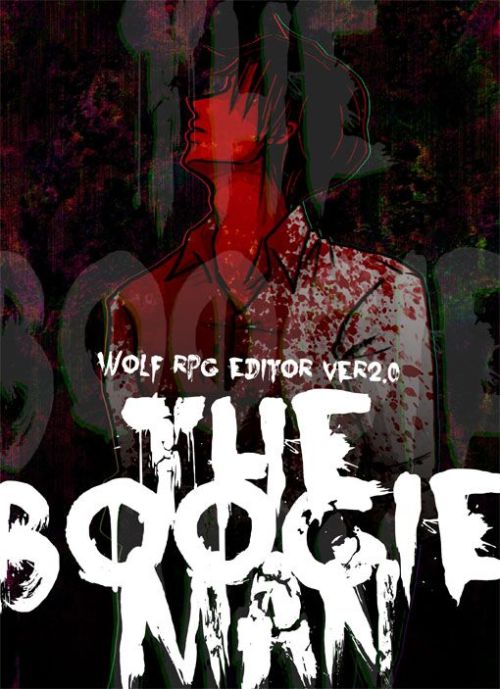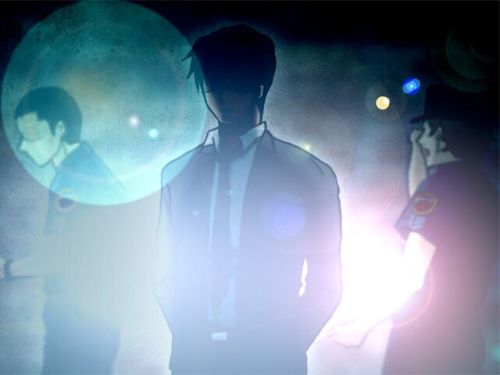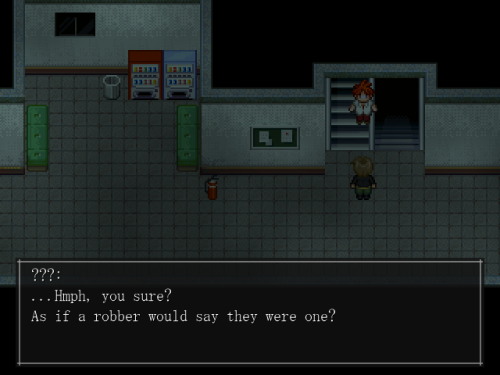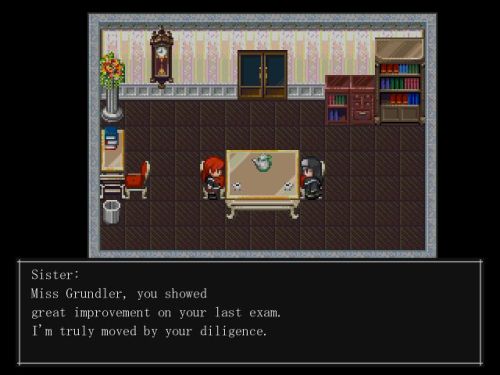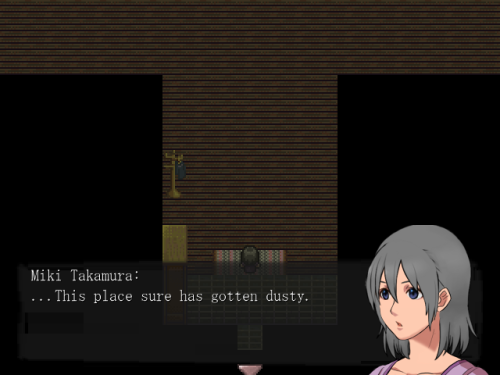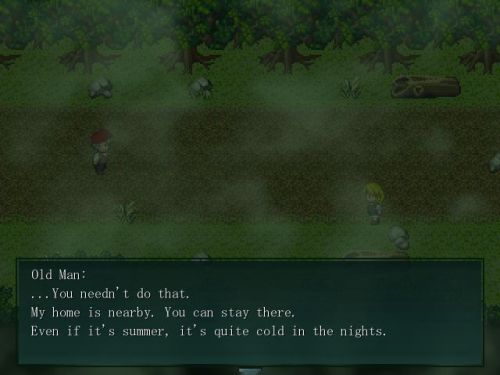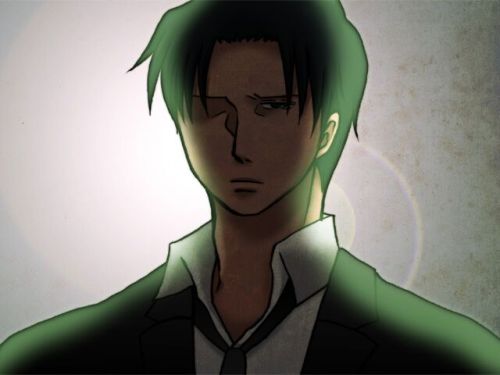nurvuss: Boogie Down: An Interview with Uri. (from MisanthroPop) Uri is an indie game developer base
nurvuss: Boogie Down: An Interview with Uri. (from MisanthroPop) Uri is an indie game developer based in Japan. Primarily working with Wolf RPG Editor, Uri is known for creating horror-tinged adventure games that tend to examine the darker side of the human psyche. In the past few years she has developed a sizable worldwide fanbase due in no-small-part to her relationship with British translator vgperson, allowing her games to reach a much wider audience and opening the door for them to be promoted by YouTube Let’s Players. Uri’s latest game is The Boogie Man, released today. The hotly-anticipated third part of her Strange Men series comprising of The Crooked Man and The Sandman, The Boogie Man tells the story of hard-nosed detective Keith Baring who, following a particularly brutal murder case, is placed on administrative leave by his superiors. Keith decides to spend his forced vacation staying in an old castle with his wife Helena as part of a tour group, but any plans of a relaxed trip are thoroughly quashed by the appearance of a malicious killer calling himself The Boogie Man. When several members of the tour group are kidnapped, including Helena, Keith resolves to stop The Boogie Man before he has a chance to kill and save his wife in the process. A first for the series, The Boogie Man is notable notable for its fully-voiced dialogue provided by a team of actors spread throughout the globe. I was honored enough to be one of those actors, playing the role of disagreeable photographer Lance Kanal. To celebrate the release of The Boogie Man, I sat down with Uri to talk about the game, her creative process, and what she has on the horizon. On The Boogie Man: Congratulations, Uri! You’ve just released your latest game, The Boogie Man. How do you feel? I’m filled with joy that I can finally release it, but I know that this isn’t quite the end. I still have to respond to any bugs that come up, for instance. But I’m relieved that I can take a bit of a rest for now. Was The Boogie Man your first bilingual project? How was it working with a voice crew spread out all over the world? Did you face any challenges during the process? Actually, I already had vgperson’s help for The Sandman to have a simultaneous release of Japanese and English versions, so it’s not quite the first. The appointment of English voice actors started with me saying on Twitter that I wanted to do it, and vgperson offering her assistance. She looked for sites to recruit voice actors, translated all the material for the auditions, translated the dialogue scripts and messages to the voice actors - basically everything, every step of the way. If it weren’t for vgperson, The Boogie Man surely wouldn’t have had full voice acting. I’m truly grateful to her from the bottom of my heart. Also, I’m very glad I could make this game alongside all the voice actors. Alas, I’m no good at English, so I told them some mistaken things and troubled them with misunderstandings. But having third-party eyes on the process of creation was of significant aid to me. As for challenges, that would be writing the scripts and processing the voice files. I’m a slow writer, so the scripts came slowly, and I really made the voice actors wait… Also, implementing a scene skip function in this game for the first time was a pretty big challenge. The Boogie Man, despite its gruesome murders, might be one of your most comedic works to date. The eponymous Boogie Man has a very unique sense of humor, employing a playful leitmotif when he’s introduced and frequently breaking the fourth wall. As such, it stands apart from the other games in the Strange Men series. Could you tell us more about your use of humor in this game? I started out making this game like a B-movie from the start, but looking back on it now, it feels more like a play. It’s sort of like the characters put on a show as the player observes them as the audience. You can think of Keith like a clown on a stage, and with an outsider’s perspective, perceive his running around as comedic. His beloved wife is being chased by the villain, yet he prioritizes the safety of the hostages and says he can’t allow any more casualties, unable to just charge after his wife. The player might be irritated to see Keith acting that way. It’s why Lance says to Keith, “If you wanna save your woman right now, then do it!” What Keith should really put first is beating the Boogie Man. Helena is being chased by him, so stopping the Boogie Man will bring him to Helena. But he fails to realize this, and ends up always a step behind. I suppose that’s one of the comedic elements of this story. The Boogie Man sneers at Keith for it, taunting him so as to confuse him. His defining trait is seeming to know everything about people and using it to scare them. Normally, the only person in a story who “knows everything” is the author. The Boogie Man is not merely a villain, but sort of a stage prop prepared by the author. Thus he always acts silly, and makes all these references and parodies. The whole cat-and-mouse act between Keith and the Boogie Man with Helena in-between is the core of the game. Those involved may be deadly serious, but the all-seeing player sees it as silly. That’s why the villain, the Boogie Man, simply has to be a silly, absurd figure. Any personal favorite characters of yours from TBM? All of the characters in TBM really felt like “humans” to me more than “characters.” Because they all have tangible voices, and they’re emotive and lively. It was really interesting being able to regard these entities I’d created as human for the first time. So it’s extremely hard to answer who I like best. (laughs) I think they’re all good people, I like them all. Even the Boogie Man was a fun heel to make. If I had to say, maybe Keith, who I have extra attachment to due to the difficulty of making him a real person. Who was Lance talking to on the phone? A colleague at the publisher he works for who writes gossip. Lance is all “If I get any juicy info…”, and keeps bothering Keith. Trying to make him angry, intentionally taking punches, etc. He probably thought it might result in some good gossip material. And he doesn’t like the police, so. Though ultimately, after the incident, he doesn’t tell his colleague about it or anything. On Her Creative Process: What are some of your main influences? That’s a tough question. But when I thought up this story, I was listening to music, so I guess there was a strong musical influence, yeah. And in fact, they’re things which are actually incorporated in the game. For instance, the title of The Crooked Man’s Good End was Bye Bye Blackbird, a famous jazz song. The Sandman was based on Metallica’s Enter Sandman. For some reason I thought of The Boogie Man while listening to The Jacksons’ Blame it on the Boogie… (laughs) So the lyrics “blame it on the Boogie” do come up. While creating it, I listened to things like Black Eyed Peas’ The Boogie That Be, No Doubt’s Tragic Kingdom, etc. Also, one of the bad endings in TBM is called White Room, a song by Cream. Other than music, I think movies were a big influence. Especially old horror and suspense films. The Exorcist is my favorite horror movie, and I love the direction in The Silence of the Lambs. I thought at times of wanting to recreate a kind of irrational scariness like Hitchcock’s The Birds, but surely that’s impossible… Can you tell us a little bit about your creative process? How you get your stories started, how you create characters, etc. Thinking “I want to make a scene like this!” is the beginning of everything.For instance, the conversation between David and Duke in The Crooked Man’s second loop, Sandman writing the letter to Sophie in The Sandman, the Barings talking in front of their son’s grave in The Boogie Man… Honestly, those single scenes served as an impetus to create the entire story. I just suddenly think “I want a scene like this” while drinking coffee and relaxing, say. And I make a story to have that scene in, and start making characters. I’ve never struggled much with thinking up a story. What I want to make always naturally comes to mind. The characters seem to be born as the story comes together. The link between the story’s progression and the protagonist’s personality and actions is an unbreakable one. The protagonist moves with the story, and sometimes it’s very important for progression to have others who serve as mirrors to the protagonist. In The Boogie Man, Lance, Richard, and David are important as Keith’s mirrors. Lance has a clear will of his own and acts accordingly. Richard is a loving parent. David is a reliable husband who loves his wife. They also symbolize Keith’s suppressed emotions. Keith’s interaction with them moves his heart, taking the story forward. In that way, each character is made to fulfill a purpose. As for character appearances, it’s just whatever fits, and doesn’t clash too much with other characters. But I realized later that Keith resembles Keanu Reeves as Constantine. (laughs) Your Strange Men trilogy uses well-known figures from Western fables and mythology as its basis. Could you tell us a little bit about what drew you to these stories? The initial idea for The Crooked Man was reading the Mother Goose rhyme There Was A Crooked Man, which left me with the impression of it being an eerie and sad story. There’s a scene in the game where David says he heard it in his youth and thought it was sad, and that’s also the author’s impression of the rhyme. As for The Sandman, even I’m not sure what drew me to it. I just somehow knew about the Sandman, and suddenly thought, “Isn’t putting everyone in the world to sleep some super hard labor? When does Sandman sleep?” That was the conception of that story. And The Boogie Man… Actually, I don’t know much in particular about the Boogie Man. I did some research, but ultimately found there was no particular story to the Boogie Man, it’s a mystery where it all came from, and there’s no concrete appearance or even name. I only knew he was like an embodiment of fear and unease. So the Boogie Man is essentially this incomprehensible entity which people don’t understand. And people feel most fearful of what they don’t understand, don’t they? Even Lance says he’s scared by how he doesn’t know what Keith is thinking, right? I wanted to make this game’s story around that idea. My motive to start on it was to differ from previous works and depict him as an incomprehensible, monstrous person. Essentially, the protagonist Keith suppressing his emotions so much results in a monster like the Boogie Man. By the way, I’m not intentionally using fables as motifs. The Boogie Man isn’t really a character from a fable, and later games in the series aren’t going to fit that either. On Her Other Games: I understand one of your earlier games, Paranoiac, was made into a film recently. It’s very rare to hear of an indie game being adapted to other mediums, let alone the screen. How did this come about? I was surprised too. One day, out of the blue, I just received an email from a production company. The person who sent the email had a sibling making an indie horror game, and had interest in my works. The company was the same ones who make the “Scary Videos That Really Happened” series my brother and I always watch. To think they would make a movie of Paranoiac! I gladly gave them permission. They showed me proposals and scripts, and even invited me to filming, but I was generally too busy to attend… In the end, I still haven’t even watched the movie yet. (laughs) I want to see it soon! What’s your favorite project to have worked on to date? Once they’re finished, I feel strong affection for all of my works. But I’m fond of the Strange Men series, and I really want to see it through to a conclusion. But if I had to pick a single game I’m satisfied with, I suppose Mermaid Swamp. Have you worked on any games that you ended up having to cancel the release of? If so, could you tell us a little bit about them? Not at the moment, but there is one I was thinking I might cancel, yet decided I would aim to release. That’s Pedestal. Actually, it was meant to be a sequel to Paranoiac. While working out the story, I felt like I couldn’t make it an interesting horror game, and gave up on release for a time. But thinking it might work if I go more for suspense, I restarted the idea. Basically, all the games I have ideas for are ones I still want to release. But I can’t make games forever, so it’s hard to say how many I’ll finish. I think Mermaid Swamp is a particularly interesting work of yours. On its surface it presents itself as an allusion to ningyo folk stories such as Happyaku Bikuni, but ends up drawing inspiration from more unlikely sources such a Hamlet and Pre-Raphaelite art, crafting a tale that is as unexpected as it is unique. Could you tell us more about how this story came together? (Warning: Spoilers for Mermaid Swamp are contained in Uri’s answer) This’ll get long, but I’ll explain. This game was made to unease players with the mixing of contradictory elements. Just as you say, the mermaid legend in the game is Japanese folklore, but all around you there’s a western house and western paintings, things out of character for Japan. So first, we have those opposing elements of “Japanese” and “western.” And in the legend, a mermaid who should live in the sea is taken all the way up to the mountains, adding more opposing elements: “mountain” and “ocean.” Furthermore, beautiful women being killed and not allowed to rot even as they change into a hideous form - “beauty” and “ugliness.” The story purposefully has all these elements that shouldn’t normally be mixed together. To give some simple examples, we’ll start with the protagonist Rin. Appearance-wise she looks very beautiful, but in contrast to that, she’s rough and violent. The old man behind the incident thinks of the mermaids as “beautifully ugly,” hating them yet loving them.He regretted letting his wife and children die to the mermaid curse, so he must have had a grudge against the mermaids. He has to let the mermaids free, but he can’t do it, being too attached to them. So he gets the unrelated protagonists involved. The old man’s contradicting “love” and “hate” for the mermaids serves as the beginning of this story. I’ve seen people’s thoughts on Mermaid Swamp, and there are those who despise the old man and those who sympathize with him. Even regarding the game itself, it seems that some call it a disturbing story and others call it a beautiful one. Perhaps they feel both ways and can’t boil it down to one. That’s exactly what I was going for. I wanted everyone to get all these different impressions. It’s simple to make a pure and beautiful story. The same goes for a story that’s just disturbing. But aren’t those kind of boring? I wanted to make a game that just barely managed to balance reason and emotion, and wanted it to have various tastes for players, so that’s why I made Mermaid Swamp what it is. On What The Future Will Hold: Now that the Boogie Man is complete, what’s next for Uri? I would love nothing more than to release Pedestal, for which there was a preview video, next. But I intend to make all the graphics myself, so it’s taking some time. And it’s different from previous games, being more about suspense. So I think the next game will be the next part of this series. Since I have this interview to do it in, I’ll say a little bit about the game. The title is The Hanged Man, and the protagonist is, of course, a brand new character. Like The Crooked Man, The Sandman, and The Boogie Man, it will follow the previous games chronologically. However, it will probably be my last game which can be considered a sequel in that respect. Is there anything else you’d like to say? Well, while I’m here, I’ll say my thanks to you, Nurvuss. I struggled a great deal picking voice actors who suited each character from all the auditions. But as a matter of fact, you were an instant pick for Lance. That’s how much your speaking and performance matched my idea of Lance. It really surprised me, actually. Your files were always clean and so well-acted, which was truly very helpful. I really value the fact that you gave such a good, solid performance. Meeting you has been one of many happy experiences I’d had in making The Boogie Man. And I’ve really enjoyed answering questions for this interview! I’ve said it a thousand times, but thank you again for doing voice acting for The Boogie Man! I wish you the best for your future endeavors. And say hi to your friend Borscht for me! I’m very flattered that you feel that way and I feel that you do me too much honor. It was an absolute joy to work alongside you I’m proud to have been part of your latest project and I hope that we can work together again one day. Thank you, Uri, for taking the time to be interviewed! And a very special thank you to vgperson, who acted as interpreter between Uri and myself. This couldn’t have happened without you. -- source link
Tumblr Blog : nurvuss.tumblr.com
